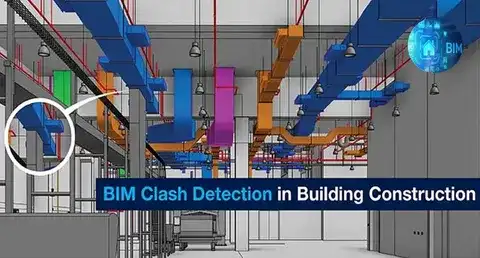The role of Building Information Modeling (BIM) is enhanced electrical clash detection and costing. It has changed manual methods to a digital representation of the physical and functional characteristics of buildings. However, if we talk about electrical engineering and construction, they have now become more complex due to demand and occupants’ needs. That is why experts use BIM to optimize cost and detect clashes. Plus, in this competitive era, there is no chance of mistakes because it ends up with failure and over budgeting.
Well, the modern electrical systems are quite complex, which must align with structural, mechanical, plumbing, and architectural elements. For this reason, 2D design methods result in future rework and budget overruns. But BIM can help you tackle such challenges with the design process of electrical systems. Without any further delay, let’s discuss the insights.
DIVING TO EXPLORE THE INSIGHTS OF HOW BIM HELPS CONTRACTORS AND ESTIMATORS IN ELECTRICAL CLASH DETECTION AND COSTING?
Electrical Clash Detection in BIM
How does an electrical clash occur? It happens when conduits, cable trays, or equipment conflict with other building elements or systems. It can be:
Hard Clashes
In hard clashes, the electrical parts are placed in building structures, air ducts, or plumbing pipes. However, this means that electrical wires are passing through support beams or electrical panels.
Soft Clashes
Soft clashes occur when electrical components do not match safety codes. This situation includes insufficient working space around electrical panels and inadequate separation from other utilities.
Temporal Clashes
This includes a sequence or timing of the electrical system installation. However, this matters mostly for complex coordination sequences.
The BIM Advantage in Clash Detection
With the help of advanced BIM platforms, you can detect clashes before the construction work starts. This modern tool is embedded with Advanced algorithms that help in analyzing 3D plans and geometry. However, it is an automated process that reduces the overall time and provides thousands of potential clashes in minutes.
The results are precise, and it depends on the level of detail (LOD) in the model. For electrical systems, LOD 350-400 consists of enough details for precise equipment dimensions, conduit routing, and connection points. After that, modern BIM software detects clashes down to millimeter accuracy.
Cost Implications and Benefits
Reduced Rework Costs
According to the latest studies, if you are successful in detecting the clash in the design, the overall construction rework costs are reduced by 70-90%.
Labor Cost Optimization
With the help of BIM, professional cost estimators provide accurate construction estimating services to their clients. They extract precise labor hour estimation and quantities for installation.
Material Cost Control
On-point BIM models help experts to provide exact material takeoffs, reducing waste and over-ordering. This way, the clients can only invest their money in those materials that are required. Plus, if you rely on professional assistance, then you can plan your construction projects more accurately.
Change Order Reduction
The other benefit is the early detection of mistakes or clashes to cater to change orders during the construction phase. However, it not only saves your budget but also the timing, which is essential and makes it valuable!
ROI Analysis
According to the research, every dollar invested in BIM clash detection generates $3-7 in savings during construction. Talking about electrical systems, the ROI is higher because of the complexity of these systems.
However, our commercial electrical project needs $50,000 to $100,000, and then save $200,000-$500,000 with the help of building information modelling by avoiding delays and rework!
Best Practices and Recommendations
Establish Clear Standards
You must be aware of the standards to develop accurate quality control procedures.
Regular Model Audits
Keep regular model checks to detect any issues or clashes before the construction process begins!
Version Control
Control means that you have to work smartly on Clash detection to cater to the latest design changes.
Interdisciplinary Coordination
The other way to handle clash detection is to conduct regular meetings and review them to plan efficient strategies.
Clear Responsibility Matrix
You must have a clear plan for who is going to be responsible for handling the clashes and resolving them.
Communication Standards
Experts are responsible for following standard procedures or formats for reporting clash detection results and status.
Hardware Specifications
As an expert in this modern industry, you must use advanced computing resources for the analysis of complex clash detection.
Software Integration
Plus, your processes must be strong to tackle clashes. That means you must use advanced software and techniques to manage your project and design changes.
FOR ACCURATE BIM ESTIMATING SERVICES, YOU CAN CONSULT OUR COST ESTIMATORS AND ENGINEERS TO IMPRESS YOUR CLIENTS AND SECURE PROFITABLE PROJECTS!
Conclusion
To sum it up, the role of BIM in electrical clash detection and costing is quite impressive. The experts who use such advanced technology are automating the process of identifying and resolving conflicts in less time. This way, the overall results are also enhanced, and contractors can secure profitable projects and impress their clients.
Plus, the ROI for BIM class detection is quite impressive and positive because of the savings. But it needs proper workflows to be implemented. So, as an inexperienced person, you need to develop smart strategies with the help of professional cost estimating services. However, using BIM is not an option; implement it in your workflows to generate error-free results!

